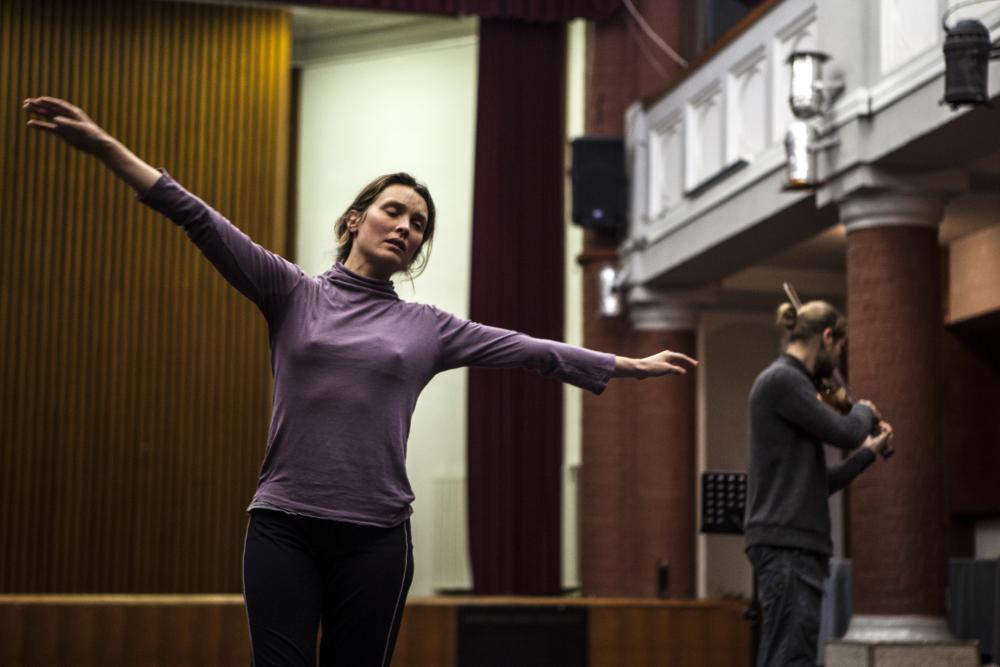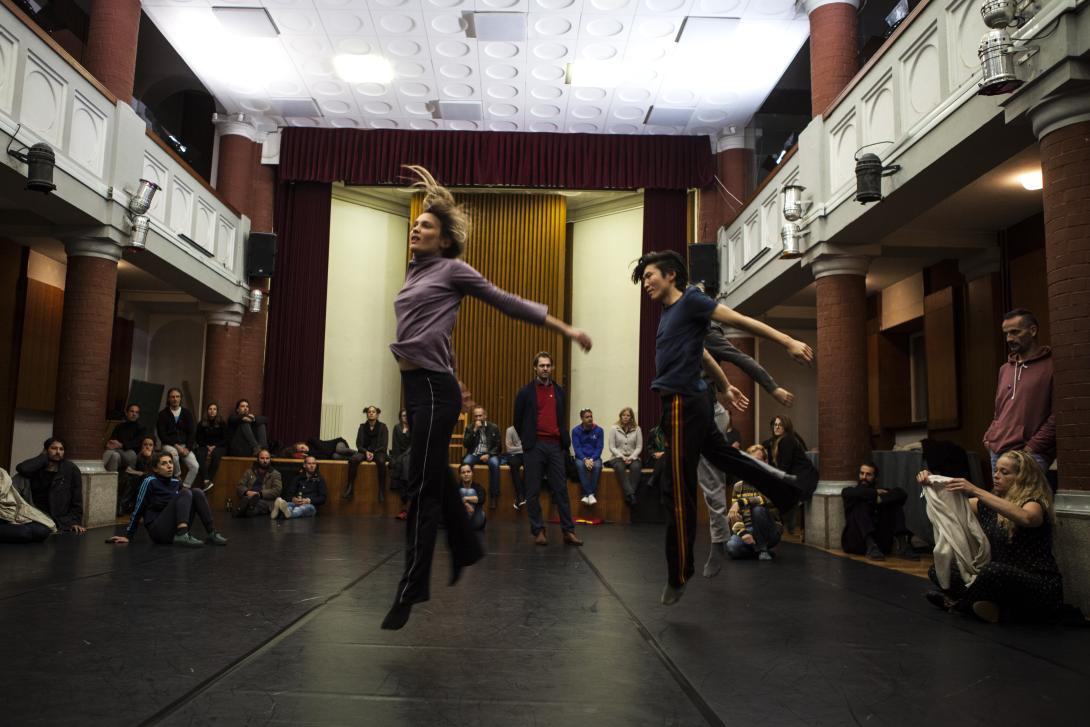‘CAN WE DANCE IN THIS PLACE? OR FROM THIS PLACE?’
an interview with Laurent Chétouane
Where did the idea of letting go of verticality come from?
This idea has occupied me for the last five years. More or less since Sacré Sacre du Printemps. I have been formulating it differently in the past, but the main point is about the possibility to have another relationship to frontality. Many choreographers I admire have worked on this question, such as Merce Cunningham, Deborah Hay or William Forsythe. To organise and create spaces, our eyes use frontality for primary orientation and construction system. The gaze and the verticality are related to each other. You can feel it when you get up from the floor: there is a moment when the eyes take over the movement of the body and guide your orientation. So in order to challenge frontality we need to leave out verticality and to question our relationship to our eyes while moving. Not just as a game for a few seconds, as a momentary fall – like Balanchine so brilliantly did – but as a perpetual loss.
What does this letting go of verticality mean for you? Is it a liberating gesture? Or is it rather a way of losing control?
Many questions appear when you let go of verticality: how to orientate yourself? What does movement mean when the eyes are not controlling it? What is a space without any front? What is the impact on the spectators? But what I like – to formulate it in more political terms – is the fact that it takes away the hierarchical position of the human being among the different species in nature. Animals do not know fronts as such. They are in the world, the world is not in front of them. They do not own it with their eyes. Taking away verticality puts us back in the middle of the world without anything ‘elevated’ anymore. Fragile. Unstable. Like our time. Without any overview which a certain use of the eyes would afford us.
We are all a bit blind today, without any orientation towards a common future. Something seems to be changing radically in the world, which questions the human being deeply. Our values and orientation systems are about to disappear. New ones will come. But we cannot think, conceptualise them right now. For the first time in the history of the modern human we are not able to anticipate and plan, project. Something will end. Can we dance in this place? Or from this place? If yes, then we need to fall…
In this perspective, dance looks very precarious, almost impossible. We feel the constant effort of finding balance without the use of our eyes, and it obliges us to think with the pure materiality of the body, its ‘symmetrical’ construction in order to stand. The body appears as something we can not fully master anymore. We need to enter into dialogue with all our body parts together in this very precarious state which is no longer supported by a vertical reference.
Did Bach’s violin partita trigger the idea, or was it the other way around – the Partita seemed to fit the concept?
I have been working with Bach pieces for four years now. I’m learning to dance through him. For me, this composer is the perfect example of crossing verticality and horizontality. For me verticality is a consequence of a horizontal fall, a horizontal chaos between highly structured thinking and unpredictable events. A river with a lot of turbulences. And this produces an ‘unstable stability’ in which the movement never stops. No ends, no beginnings. A constant transitionlessness. Verticals are very fragile!
Partita 1 recalls this character for me. I worked with Artiom Shishkov on a way for him to emphasise this horizontality even more, creating something like a loose spine within the music. But it is already part of Bach’s music. We rather support it.
The Partita-pieces are study pieces. Practice pieces actually. That is what I like in these short, modest parts: they only last three or four minutes. Together with the dancers, we searched a main theme for each of the four movements, that would show the audience what this loss of verticality might entail: on a technical dance level, and more psychological. How do we meet, touch and approach each other without verticality?
Taking a musical piece as a starting point isn’t new in your work. You already presented BACH/PASSION/JOHANNES and Sacré Sacre du Printemps at Kaaitheater. What moves you to depart from such masterpieces to create a choreography?
I learn from them. To me, they propose a musical space I am enveloped in. I do not understand the dance space as a Euclidian room in which music sounds. Music unfolds very special rules regarding space and can help to think about space differently, with depth, streams, velocity, thickness, turbulences, waves... Sacré Sacre du Printemps proposes collisions of spaces, and the floor as percussive surface. Johannes Passion makes you feel gravity, weight and volume. Musical pieces also helped me to understand how it is possible to move without thinking in pictures, ideality, eyes, but in volume, body, materiality.
These pieces helped me to find the body I work with on stage. And rather than reducing or destroying these pieces, as it sometimes has been seen or interpreted, I question the images of European culture we carry through these masterpieces. The expectation we have from them. They emerged at different key moments in the history of the modern subject. They formed our thinking, our verticality. In order to fall from the vertical I need to confront these references. To know what I am falling from.
Are there similarities in the way you create a choreography to these music pieces?
All my choreographic pieces are building on each other. At the end of one piece I could see the starting point for the next one. They are different, but part of the same question. I found different answers in each piece. I understand a piece as a problem that has to be solved. A bit like a mathematical demonstration. (I briefly was an engineer before I studied theatre!) They are built up very logically. Until now, all the ends were open. Out of Joint / Partita 1 is the first piece with a clear ending. I found something with this piece. Finally.
Why is it important to have the violinist live on stage?
The violinist brings another relation to the space. He hears, and the body refers differently to verticality. Towards the end, the piece brings all these bodies together. Together they find a way of being where hearing and seeing are become equivalent. As important. Happening at the same time. Maybe a utopian place for the future.
What influence does having studied engineering have on your choreographic practice? Do you notice a way of looking or a logic that can be traced back to this study? Or are there similarities between engineering and dance? The constructive side of it maybe?
The logic. Trying to find reasons for movements which are closer to physical systems than to subjective, visual desires. The necessity of things is important to me. The logic within a system, and that the system thinks by itself. Understanding these constellations which allow this to happen is what I loved in mathematics, physics, chemistry. You are in dialogue with something bigger than you. You try to understand, to answer the question.
An interview with Laurent Chétouane on Out of Joint / Partita 1, bij Eva Decaesstecker (Kaaitheater, January 2018)

